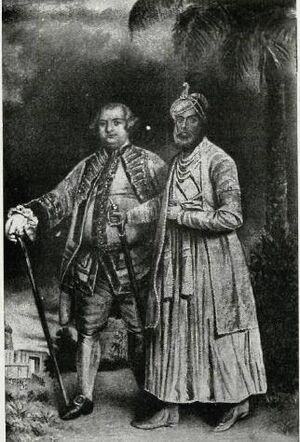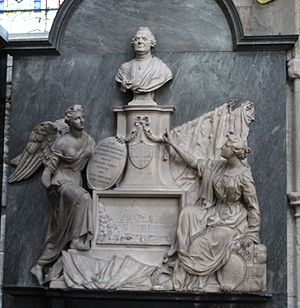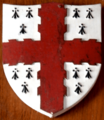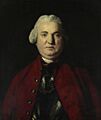Stringer Lawrence facts for kids
Quick facts for kids
Stringer Lawrence
|
|
|---|---|

Portrait by Thomas Gainsborough, National Portrait Gallery, London
|
|
| Born | February 1698 Hereford, England |
| Died | 10 January 1775 (aged 76) London, Kingdom of Great Britain |
| Allegiance | |
| Service/ |
British Army East India Company |
| Years of service | 1727–1766 |
| Rank | Major-General |
| Commands held | India |
| Battles/wars | Jacobite rising of 1745 First Carnatic War Second Carnatic War Third Carnatic War Battle of Golden Rock |
Major-General Stringer Lawrence (February 1698–10 January 1775) was an important English soldier. He became the first Commander-in-Chief of the British forces at Fort William in India. He is often called the "Father of the Indian Army" because of his work in training and leading soldiers there.
Contents
Early Life and Beginnings
Stringer Lawrence was born in Hereford, England, in February 1698. His father was John Lawrence. Not much is known about his early family life. He was baptized in a church in Hereford on February 27, 1697 (using the old calendar).
A Soldier's Journey

Lawrence joined the army around 1727. He served in places like Gibraltar and Flanders. He also fought in the Battle of Culloden in Scotland. This battle was part of the Jacobite rising of 1745, where people tried to put a different king on the throne.
In 1748, Lawrence was a major. He was known as an experienced soldier. He then traveled to India to lead the troops of the British East India Company. At this time, the French, led by Dupleix, were trying to take control of southern India.
Soon after arriving, Lawrence was busy fighting. He stopped a surprise attack by French troops at Cuddalore. However, he was captured by French cavalry while helping Admiral Edward Boscawen at the Siege of Pondicherry. He remained a prisoner until the peace treaty of Aix-la-Chapelle was signed.
Working with Robert Clive
In 1749, Lawrence was in charge when the British captured Devicota. One of his officers was Robert Clive (1725–1774). Clive later became a very famous leader in India. Lawrence and Clive became lifelong friends.
Clive respected Lawrence greatly. When Clive became famous, he refused to accept a special sword of honor. He said he would only take it if Lawrence also received one. Clive believed Lawrence was the true creator of the Indian army.
Return to India and Key Victories
Lawrence went back to England in 1750. But he returned to India by 1752. He found Clive leading a group of soldiers to help the city of Trichinopoly. Lawrence, being the senior officer, took command. But he made sure Clive got full credit for his part in the battles.
These battles included saving Trichinopoly. They also led to the French army surrounding the city giving up. In 1752, Lawrence won against the French at Bahour, even though he had fewer soldiers. In 1753, he again helped Trichinopoly. For the next 17 months, he fought many battles to defend the city. He eventually arranged a ceasefire, which led to a peace agreement. He remained the commander-in-chief until regular British army troops arrived.
In 1757, he helped in battles near Wandiwash. From 1758 to 1759, he was in charge of Fort St George in Madras. This was during a time when the French, led by Lally, were trying to capture it.
In 1759, Lawrence's health got worse, and he had to go back to England. But in 1761, he returned to India. He was now a major-general and commander-in-chief again. Robert Clive, his old friend, gave him £500 a year to help with his income. In 1765, Lawrence helped reorganize the army in Madras. He finally retired from the army the next year.
Later Life and Legacy
After retiring, Stringer Lawrence lived in England. He was a guest of his friend Sir Robert Palk, 1st Baronet (1717-1798). Palk was also an officer with the British East India Company. He had been the Governor of Madras. Lawrence lived at Palk's home, Haldon House, in Devon.
Lawrence passed away in London on January 10, 1775. He was buried in Dunchideock Church in Devon. This was the church for the area where Haldon House was located.
Lawrence left a large sum of money, £50,000, to his friend Palk. Palk built impressive monuments to remember Lawrence. One was the Lawrence Tower, which is 26 meters (85 feet) tall. It has a statue of Lawrence dressed like a Roman general. The tower also has three large stone tablets that tell about his military career. Palk also put up a monument for him in Dunchideock Church. Palk even named his son and heir "Lawrence" to honor his friend. This became a tradition in the Palk family.
Monuments to a Hero
Many monuments were built to honor Stringer Lawrence. They show how important he was to the British East India Company.
Westminster Abbey Monument
The East India Company built a beautiful monument to Stringer Lawrence. It is in Westminster Abbey in London. The monument is made of white and colored marble. It was created by the sculptor William Tyler.
At the top of the monument is a bust (a sculpture of his head and shoulders). Below it is a medal with his birth and death dates. On one side, there is a winged figure representing Fame. She holds a shield that lists his achievements. These include "Discipline Established," "Fortresses Protected," and "French and Indian Armies Defeated." On the other side, a female figure sits on a bale, representing the East India Company. She points to Lawrence's bust. At her feet are French and Indian flags.
The monument also shows a sculpted picture of a city and an army camp. This represents "Tritchinopoly," the town Lawrence defended for many months. The main message on the monument thanks him for his great service leading the forces in India from 1746 to 1766.
London Statue
A life-size marble statue of Lawrence stands in the Foreign and Commonwealth Office in London. It was sculpted in 1764 by Peter Scheemakers. The statue shows him dressed as a Roman general. The East India Company ordered this statue in 1760.
Monuments in Devon
The 26-meter (85-foot) tall triangular Lawrence Tower, now called the Haldon Belvedere, was built in 1788. Sir Robert Palk built it to honor Lawrence. Inside the tower, there is a statue of Lawrence. It is similar to the one in London. The walls have three large tablets that describe Lawrence's career. There is also a copy of his portrait by Thomas Gainsborough.
Lawrence was buried in St Michael's Church in Dunchideock. This is the church for the area where Haldon House is. Palk also put up a monument for him here. This monument was also made by William Tyler. It includes a marble profile of Lawrence and three inscriptions.
Images for kids
-
1795 engraving of a portrait by Sir Joshua Reynolds.
-
1761 portrait by Sir Joshua Reynolds, now in the British Library, London.
-
Marble relief sculpture of Stringer Lawrence by William Tyler, from his monument in Dunchideock Church.
-
1764 statue of Stringer Lawrence by Peter Scheemakers, in the Foreign and Commonwealth Office, London.










